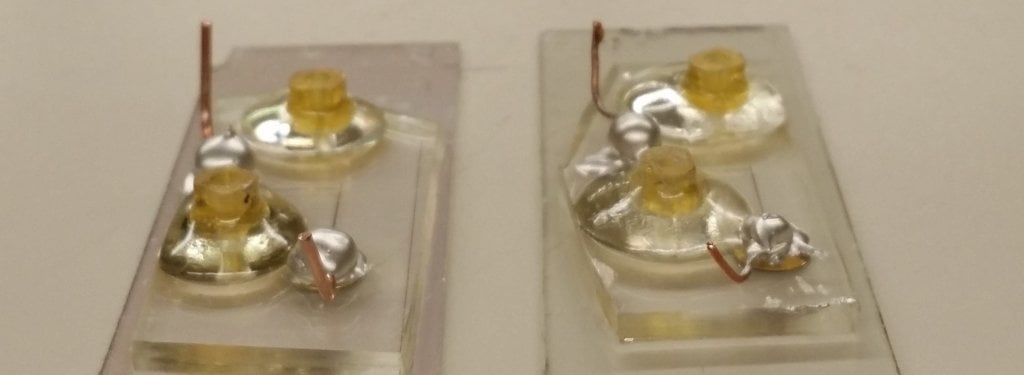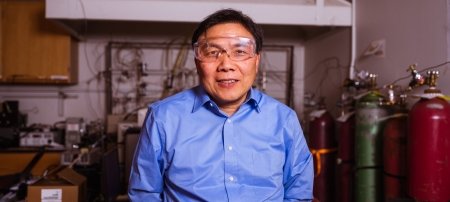Seeing is Believing

If seeing is believing, C.K. Choi has a passion for clarity—in a very tiny world. The assistant professor of mechanical engineering's research lies at the micro-scale, in channels no thicker than a strand of hair.
Choi’s first visualization breakthrough came more than 10 years ago when his team, for the first time in the world, used a confocal microscope to observe velocity fields in a micro-channel, in a space with a diameter smaller than a pin.
His next pioneering move was an innovative use of a technology Choi describes as “beautiful,” the Total Internal Reflection Fluorescence Microscope. He integrated this system with other optical devices to help researchers literally see in the dark, creating fluorescent images clear enough to examine nanoparticles and proteins near the surface.
Choi sought practical applications for his optical devices and found them in biomedical engineering. Researchers were using electrical measurements to analyze physiological changes of cells inside blood vessels, but needed an optical way to verify the data. He proposed using indium tin oxide (ITO), a common coating used in modern electronics. His hunch worked: the ITO biosensor offered the perfect marriage of optical transparency and electrical conductivity, allowing both electrical measurements and visual observation simultaneously.
The ITO biosensor led to other inter-disciplinary work—and a lot more questions. In the human body, cells are subjected to different environments: lung cells to the flow of oxygen, heart cells to pulses of blood, brain cells to electrical charges, etc. Given these radically different environments, Choi asked himself, “If I grow cells outside their normal living conditions, will they really be the same type of cells? If companies test their drugs on cells grown here [in the static environment of the lab], will their results be accurate?”
He knew that he couldn’t mimic all the body’s natural conditions, but he could at least create a device that allowed medical researchers to examine their cell lines under appropriate flow conditions.
Actually very low flow conditions, as is the case with lung cells. In his search for a device that could create ultra-low flows, Choi realized that neither direct current (DC) nor syringe pumps could be used: most mechanical pumps cannot produce consistent flow in micro-channels, and DC can physiologically affect the cells being studied. Exposure to DC can alter the metabolism and nutrients, especially problematic for stem cells which are highly sensitive to environmental changes.
Choi and his collaborators proposed using diodes, which are cheap, reliable components, to drive the current in their “electro-osmosis diode pumping” device (EOS). It worked. The EOS creates low, consistent flows in a way that does not affect cell growth and contains optical elements to visually track the fluorescent particles.
The ITO biosensor can be used to examine early stem cell differentiation—the point at which a stem cell ceases to replicate itself and actually transforms into a different kind of cell—a cell that will grow into skin, muscle, organs, etc. With the ITO biosensor and the diode pumping, Choi explains, “Early on, we are actually able to see the stem cells differentiating.”
This diode EOS has many promising applications. Because it’s so small and economical (a diode only costs a few cents), many units could be set up to culture cells quickly. Additionally, the diode EOS could be used to test the efficacy of pharmaceuticals, the presence bio-hazards or the effects of toxins. “You could take this “lab-on-a-chip” and expose it to various environmental conditions, say a radioactive area, then examine the cells at the molecular, tissue, and cellular levels to see how they were affected,” Choi explains.
His passion to help others see is contagious—and illuminating.
Michigan Technological University is an R1 public research university founded in 1885 in Houghton, and is home to nearly 7,500 students from more than 60 countries around the world. Consistently ranked among the best universities in the country for return on investment, Michigan's flagship technological university offers more than 185 undergraduate and graduate degree programs in science and technology, engineering, computing, forestry, business, health professions, humanities, mathematics, social sciences, and the arts. The rural campus is situated just miles from Lake Superior in Michigan's Upper Peninsula, offering year-round opportunities for outdoor adventure.




Comments